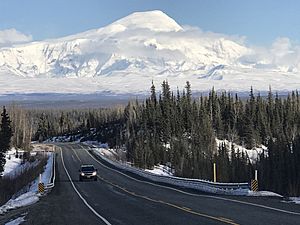Mount Sanford (Alaska) facts for kids
Quick facts for kids Mount Sanford |
|
|---|---|

Mount Sanford (left) and Mount Wrangell in 1980
|
|
| Highest point | |
| Elevation | 16,237 ft (4,949 m) NAVD88 |
| Prominence | 7,687 ft (2,343 m) |
| Isolation | 40.3 mi (64.8 km) |
| Listing |
|
| Geography | |
| Location | Wrangell-St. Elias National Park and Preserve, Alaska, U.S. |
| Parent range | Wrangell Mountains |
| Topo map | USGS Gulkana A-1 |
| Geology | |
| Mountain type | Shield volcano |
| Last eruption | 320,000 years ago |
| Climbing | |
| First ascent | July 21, 1938 by Terris Moore and Bradford Washburn |
| Easiest route | Sheep Glacier (North Ramp) Route, Alaska Grade 2 |
Mount Sanford is a giant shield volcano in eastern Alaska. It's part of the Wrangell Volcanic Field, near the Copper River. This mountain is the sixth tallest in the United States. It's also the third highest volcano, after Mount Bona and Mount Blackburn.
The south side of Mount Sanford is very steep. It rises about 8,000 feet (2,400 meters) in just one mile (1.6 km). This makes it one of the steepest slopes in North America.
Contents
What is Mount Sanford Made Of?
Mount Sanford is mostly made of a rock called andesite. It's a very old mountain. Most of it formed during the Pleistocene Ice Age. Some of its highest parts might be from the more recent Holocene period.
The mountain started growing about 900,000 years ago. It grew on top of three smaller volcanoes that joined together. Even though thick ice covers it, the top 2,000 feet (600 meters) of the mountain seem to be a lava dome. This dome fills a large crater at the summit.
Past Volcanic Activity
Two big events happened in the mountain's history. One was a large flow of rhyolite rock. This flow traveled about 11 miles (18 km) to the northeast. It was a huge amount of rock, about 5 cubic miles (21 cubic km).
Another flow came from a crack on the side of the volcano. This happened about 320,000 years ago. This flow was made of basalt rock. It marks the most recent time the volcano was active. Scientists used special methods to find out how old this rock flow was.
People have reported small activities at Mount Sanford. These are usually clouds of vapor or plumes from ice and rock falling. Some of these might just be clouds formed by the mountain itself. Others might be avalanches.
Most of Mount Sanford above 8,000 feet (2,400 meters) is covered by large ice fields. To the south, these ice fields connect with those around Mount Wrangell. The biggest glacier on Sanford is the Sanford Glacier. It starts in a steep bowl-shaped area on the mountain's south side.
History of Mount Sanford
The mountain was named in 1885. It was named by Lieutenant Henry T. Allen of the U.S. Army. He was a descendant of a person named Reuben Sanford.
First Climbs and Expeditions
Mount Sanford was first climbed on July 21, 1938. Famous climbers Terris Moore and Bradford Washburn made the first ascent. They used the North Ramp route, which goes up the Sheep Glacier.
This route is not very difficult technically. It's mostly a hike on a glacier all the way to the top. However, it's still a serious challenge. This is because of the mountain's high altitude and its location far north. Climbers usually reach the start of the route by plane. But landing near the mountain can be tricky.
On September 19, 1968, a Japanese climber named Naomi Uemura made the first solo climb of Mount Sanford. He later died after making the first solo winter climb of Denali.
Plane Crash on Mount Sanford
On March 12, 1948, a plane called Northwest Airlines Flight 4422 crashed into Mount Sanford. All 24 passengers and 6 crew members died. Snow quickly covered the plane's wreckage. It was not found again until 1999.
Images for kids
See also
 In Spanish: Monte Sanford para niños
In Spanish: Monte Sanford para niños







